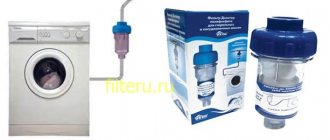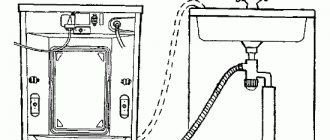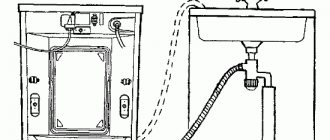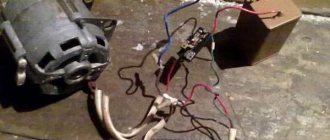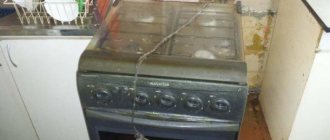It is very important to clean your washing machine periodically. If this is not done, after some time an unpleasant odor will begin to emanate from the machine, the walls of the powder receptacle will become coated, and scale will appear on the internal elements. Mold and mildew may also form. All these troubles are dangerous not only for the equipment, but also for the health of family members. How to clean an Indesit washing machine? What compositions should be used in the process? Let's look at the issue in more detail.
Complete cleaning
Before washing the machine, you should empty the drum of things, if any. Processing only individual elements of the washing machine will not bring any tangible benefit. Comprehensive cleaning of equipment carried out systematically will be effective.
What is meant by a set of activities? To keep your “home assistant” clean, you need to remove accumulated dirt from the drum, wash the powder container, remove water accumulating in the cuff, clean the garbage filter, and use special compounds to clean the “insides” of the washer.
To care for your washing machine, you can use store-bought detergents or use folk recipes. On supermarket shelves there is a large amount of household chemicals aimed specifically at cleaning vending machines. As for “grandmother’s” advice, citric acid and soda will do a great job of removing dirt and plaque; there are also recipes that include vinegar.
The cleaning composition is poured into the powder receptacle or directly into the drum, after which a washing program is set at high temperatures.
If you hear a sharp sound like a beep while the washer is operating, you need to stop the cycle as soon as possible. It is possible that a broken piece of scale has entered the drainage system. It is necessary to remove the solid interfering object from the machine and continue washing.
When to clean filters
Clogged filters are indicated by problems with the washing machine. The most common symptoms that appear are:
- slow intake and drainage of water;
- displaying error codes;
- sudden stop of washing;
- inability to turn on the “Spin” and “Rinse” programs.
If one of the problems is detected, disconnect the unit from the power supply and check the condition of the filters.
Malfunction of the filters is indicated by problems with drainage or water intake, error codes displayed on the display, and the appearance of an unpleasant odor in the drum
Cleaning the tank and drum
For these purposes, you can use citric or acetic acid or a bleach solution. The selected substance is poured or poured into the SMA drum, after which a mode is started lasting more than an hour, which involves heating the water above 75°C. Washing is carried out “idle”, that is, without laundry.
At the end of the program, it is important to run the “Rinse” twice. This will remove any remaining detergent from the tank. Users who perform this procedure once a month do not have to worry about the accumulation of dirt and debris in the drum.
It is possible to clean the surface of the drum manually. The algorithm of actions will be as follows:
- take a damp cloth or sponge. Wipe the walls, thereby moistening them;
- pour the powder onto the sponge and begin treating the surface, using special effort to clean the places where dirt accumulates;
- leave the washer for an hour so that the detergent composition is absorbed and completely corrodes the dirt deposits;
- clean any remaining debris from the walls with a dry cloth;
- run the “Rinse” mode to remove any remaining powder from the system.
You can clean the machine using Frisch Activ. For this:
- pour “chemistry” into the SMA tray (1/2 cup included in the kit), the other half - directly into the drum;
- start the washing program with the drain turned off. Water heating temperature – minimum 75°C;
- at the end of the cycle, let the machine stand for 30 minutes;
- drain the system.
Some modern models of Indesit machines are equipped with a special drum self-cleaning mode. By running such a program, you can get rid of debris on the walls without any physical effort on the part of the user. If it is necessary to get rid of scale, it is recommended to turn on the self-cleaning mode together with the use of Frisch Activ.
Filter element and hose
Cleaning a washing machine at home necessarily involves flushing the elements of the drainage system. It is in hoses, filters and pipes that the largest amount of debris accumulates. To tidy up the drain filter, you need to:
- de-energize the equipment;
- cover the floor under the machine with a dry cloth or prepare a basin to collect the water that will spill out after removing the filter;
- remove the filter element from the machine; it is located in the lower right corner of the washer. You should grab the notch and unscrew the part from right to left. In some models, the element is fixed with a bolt; it must be removed using a screwdriver;
- rinse the garbage filter;
- Use a rag to wipe the walls of the hole where the element was located. Remove foreign objects stuck there after washing.
Next, you need to inspect the drain hose. The hose is disconnected from the sewer pipe and from the washing machine, and then washed under running water. When cleaning the filter and pump, do not forget about the pump, which also needs care. To clean the drain pump, you must:
- put the washing machine on its side;
- unscrew the impeller from the pump;
- wipe the impeller cavities, as well as the internal parts of the pump, casing;
- put the impeller in place, secure it with self-tapping screws.
Some Indesits, for example, WISL models, have an additional fill filter. The mesh also needs periodic cleaning. To remove it from the washing machine, you need to turn off the water supply, unscrew the inlet hose, and remove the filter with pliers. The part is washed with running water. If necessary, you can clean the mesh with a small brush.
System health check
Upon completion of cleaning, you need to check the Indesit machine for functionality by turning it on in the accelerated wash mode with mandatory rinsing.
After waiting for the end of the cycle, you need to carefully monitor the process of draining the water and make sure there are no failures . If you find that the signs of clogging have not disappeared, you will have to disassemble the filter again and consult with specialists about its condition.
Problems after
Sometimes, when draining after cleaning, waste water begins to seep out from under the technical hatch door. This means that during assembly the filter housing is not installed tightly enough. You will have to remove it again and re-install it.
Sometimes the cause of smudges and signs of clogging is complete wear of the filter element. In this case, after receiving confirmation from professionals, you will need to dismantle it and replace it with a new product.
Powder receiver
The tray where washing detergents are loaded must also be washed systematically. After the cycle, a small part of the powder remains in the dispenser, sticking to the walls. So, over time, the particles of the substance harden, and in addition to plaque, mold and mildew may appear in the cuvette. Formations hazardous to human health are spread throughout the washing machine, remaining on clothes and laundry. Timely cleaning of the powder receptacle will help prevent the appearance of harmful substances, plaque, and an unpleasant, heavy odor from SMA.
It is recommended to rinse the powder cuvette after each wash.
When the container has no visible dirt, it is enough to simply rinse it with warm water and walk over the tray with a brush. If there is already hardened plaque on the walls, you need to soak the dispenser in a citric acid solution for several hours. Afterwards, clean thoroughly with a brush or abrasive sponge and rinse.
When the contamination is serious enough, you will have to resort to household chemicals. It is allowed to use the product for plumbing or tiles. Work must be done with gloves, as such compounds are too aggressive. If black moldy spots are visible on the cuvette, the surface should be treated with an anti-mold agent.
In very advanced cases, the powder receptacle may not be pulled out of the machine due to severe contamination. Then you can try pouring warm water into the tray and using a brush or small brush, try to clean the dispenser. If this attempt does not lead to anything, use citric acid. Place one bag into the container, the second into the drum, and start the wash. The system, and at the same time the cuvette, must be cleaned.
A heating element
Too hard water with a high content of metals and mineral salts leads to scale appearing on the elements of the washing machine. TEN is no exception. Hard deposits also form on the heater, which can lead to failure of the element.
Timely cleaning of the heating element will help prevent the part from breaking. The easiest way to produce it is using citric acid. The amount of “lemon” added to the washer directly depends on the degree to which the heater is “covered” with scale. In most cases, five packets of product are enough: the contents of four are poured into the powder receptacle, and one into the drum. Next, you need to start a mode that involves heating the water to 90-95°C.
The scale will completely disappear; the user’s main task is to ensure that it does not clog the drain system. It is recommended to do cleaning this way once every two to three weeks.
Along with lemon juice, vinegar does an excellent job of removing stains. It is more aggressive, but it will also remove scale much faster. Acetic acid (50 ml) is also poured into the detergent tray, after which the high-temperature wash program is started.
Take proper care of your machine
The service life of the washing machine and its technical condition directly depend on how the equipment is used. Caring for an automatic machine involves servicing the unit when necessary. It is easier to prevent the machine from malfunctioning than to repair the device later.
The weakest point of the Indesit machine is the powder receiver. The tray gets dirty the fastest. In second place is the drainage system. It is these nodes that constantly need cleaning. However, do not forget about the drum, the surface of which should also be wiped periodically.
The elements of SMA are affected not only by debris and lint from laundry, hard water and dirt. Most laundry detergents contain surfactants that settle on machine parts and contribute to the formation of a sticky film-like layer. Water comes into contact with the settled surfactants, transferring particles of active substances to the clothes in the drum. It is for this reason that you can sometimes see pieces of unpleasant-smelling film on clean laundry.
Some things require special care. However, if there is dirt in the tray, then even with “Delicate Wash” the laundry may be damaged, since the remaining bleach or dirt present in the system will have a negative effect on the fabric. Do not think that if particles of detergent compositions are not completely washed out of the container, This means the Indesit machine is broken. This often happens due to insufficient pressure in house communications.
By the way, powders are more difficult to wash out than liquid and gel-like formulations. However, the latter provoke the appearance of a sticky film. Both powder granules, and the layer from liquid products, and the mold that appears inevitably end up on the items being washed, and then on the human body.
This is why it is so important to clean your washing machine, no matter what household chemicals are used for washing.
What other measures can the user take to increase the service life of the “home assistant”? To prevent contamination of the washing machine, it is recommended to install a water filter at the entrance to the machine, and also wash the powder receptacle, drum, door, and cuff after each wash.
After use, it is important to leave the automatic machine open to ensure free evaporation of moisture from the system.
It is also recommended to use high-quality detergents, preferably those that do not contain surfactants and phosphates. After using bleach, you should rinse the washing machine additionally.
Interesting:
- Cleaning a Samsung washing machine from dirt
- Secrets of cleaning the washing machine drum
- Dimensions of the Indesit washing machine
- Reviews of Indesit washing machines
- How often should you clean your washing machine?
- Cleaning an Electrolux washing machine
Reader comments
- Share your opinion - leave a comment
Filter removal technology
The drain piece is made of very thin plastic material. Therefore, before removing the filter from the Indesit washing machine, you need to carefully pry it off with a screwdriver on both sides and remove it only when it begins to move away from the hole, eliminating any force.
You can remove a standard filter from its socket by turning it a couple of turns counterclockwise. Then gently pull it towards you. Remember that no matter how the water pump works, there will still be liquid inside it. Therefore, before cleaning the filter in the Indesit washing machine, place a dry cloth under the panel that can absorb water. This simple action will eliminate the hassle of liquid leaking onto the floor surface.
On some models of Indesit washing machines, the part can additionally be secured with screws. Before unscrewing the cover, you must remove all fasteners.
After the part is removed, it must be cleaned. To do this you need:
- Place the part under a tap of water and wash thoroughly.
- If the contamination is significant, you can clean the washing machine drain filter with an unnecessary toothbrush.
- Additionally, you can clean the unit by placing it in water with dissolved citric acid and holding it for several hours. This is necessary to remove unpleasant odors and lime deposits.

